Impact of Social Influence: Assessing Asch and Milgram's Studies
VerifiedAdded on 2022/12/15
|10
|2362
|143
Essay
AI Summary
This essay explores the concept of social influence, particularly through the lens of key studies conducted by Asch and Milgram. It delves into how these studies have contributed to the field of psychology by providing insights into conformity, obedience, and individual behavior within group settings. The essay examines the ethical considerations surrounding these experiments, including issues such as deception, right to withdraw, protection from harm, and informed consent. It analyzes the impact of factors like majority size and task complexity on independent behavior and discusses individual responses to social influence, such as internalization, compliance, and identification. The essay also references modern applications of social psychology, demonstrating its continued relevance in understanding and addressing social issues. Ultimately, it concludes that while ethical criticisms exist, the knowledge gained from these pioneering studies significantly outweighs the drawbacks, shaping our understanding of human behavior in social contexts.
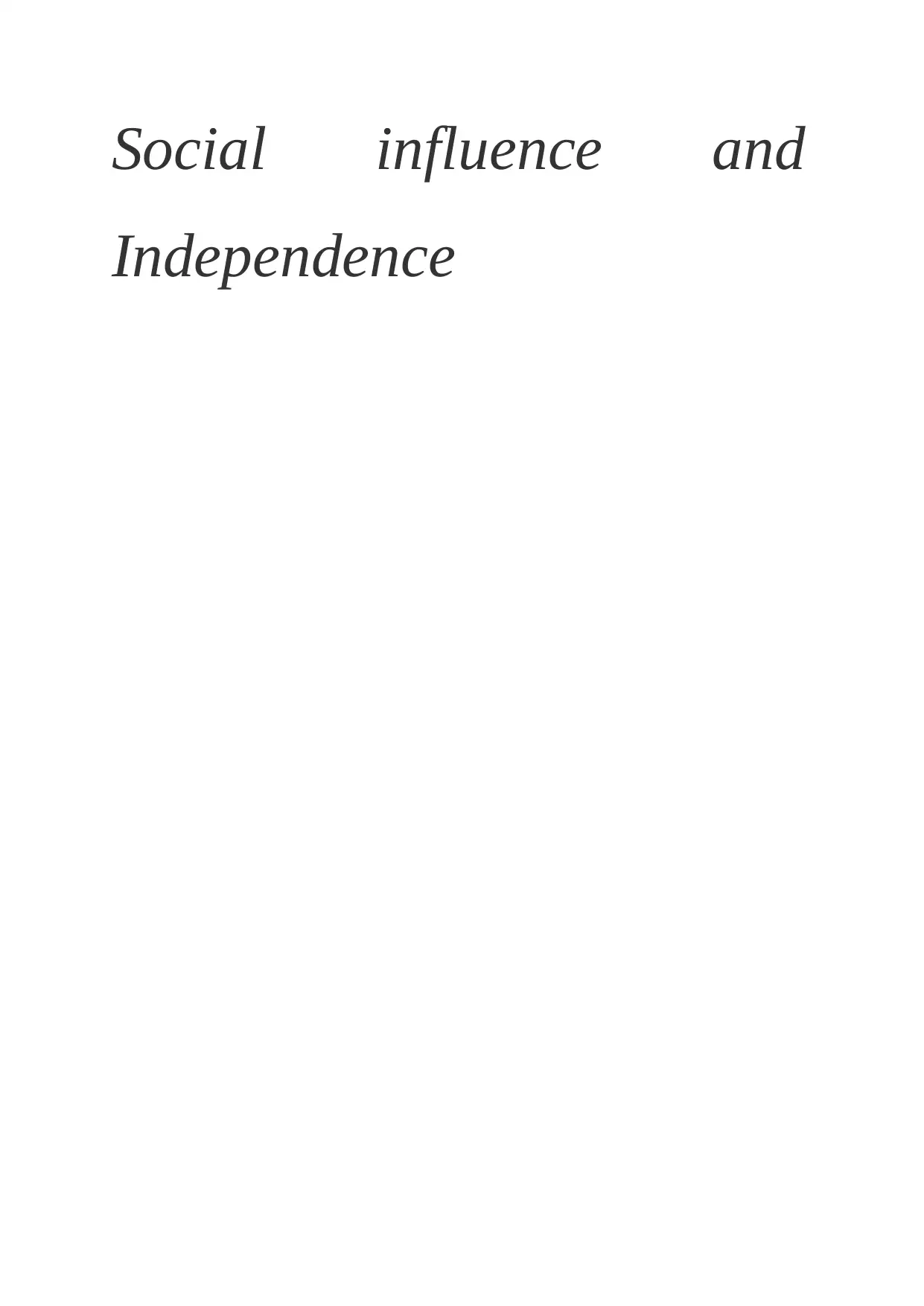
Social influence and
Independence
Independence
Paraphrase This Document
Need a fresh take? Get an instant paraphrase of this document with our AI Paraphraser
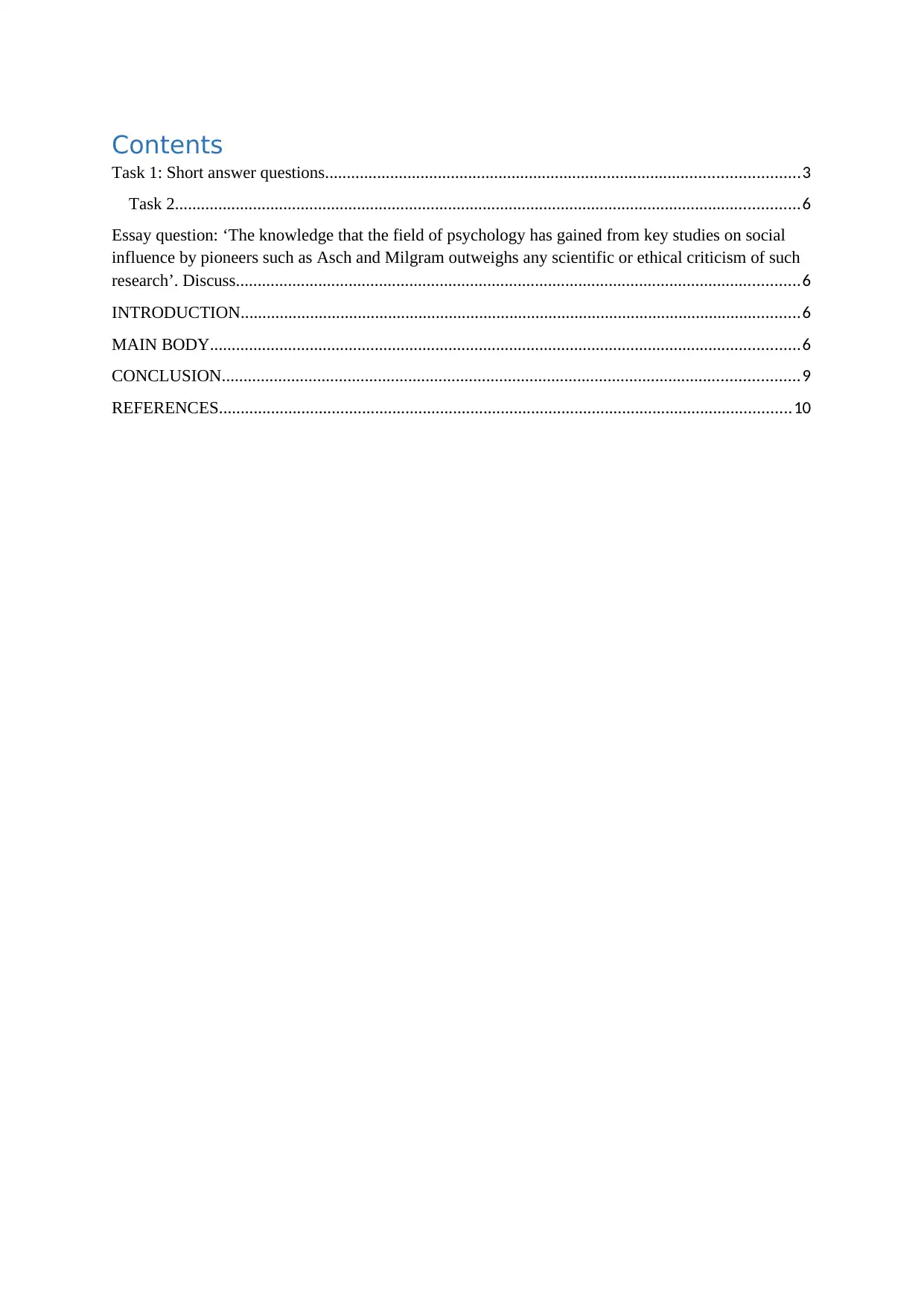
Contents
Task 1: Short answer questions.............................................................................................................3
Task 2................................................................................................................................................6
Essay question: ‘The knowledge that the field of psychology has gained from key studies on social
influence by pioneers such as Asch and Milgram outweighs any scientific or ethical criticism of such
research’. Discuss..................................................................................................................................6
INTRODUCTION.................................................................................................................................6
MAIN BODY........................................................................................................................................6
CONCLUSION.....................................................................................................................................9
REFERENCES....................................................................................................................................10
Task 1: Short answer questions.............................................................................................................3
Task 2................................................................................................................................................6
Essay question: ‘The knowledge that the field of psychology has gained from key studies on social
influence by pioneers such as Asch and Milgram outweighs any scientific or ethical criticism of such
research’. Discuss..................................................................................................................................6
INTRODUCTION.................................................................................................................................6
MAIN BODY........................................................................................................................................6
CONCLUSION.....................................................................................................................................9
REFERENCES....................................................................................................................................10
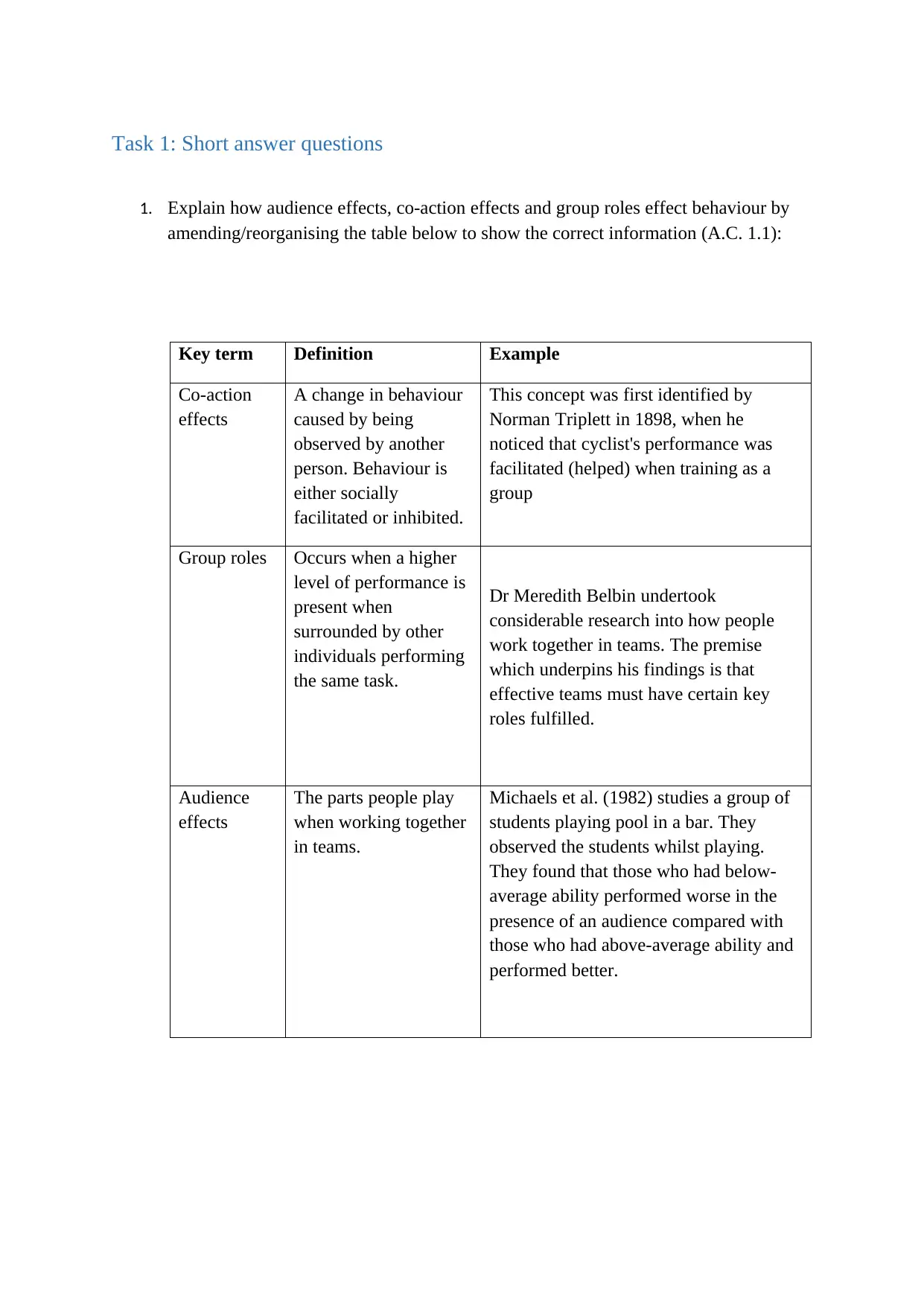
Task 1: Short answer questions
1. Explain how audience effects, co-action effects and group roles effect behaviour by
amending/reorganising the table below to show the correct information (A.C. 1.1):
Key term Definition Example
Co-action
effects
A change in behaviour
caused by being
observed by another
person. Behaviour is
either socially
facilitated or inhibited.
This concept was first identified by
Norman Triplett in 1898, when he
noticed that cyclist's performance was
facilitated (helped) when training as a
group
Group roles Occurs when a higher
level of performance is
present when
surrounded by other
individuals performing
the same task.
Dr Meredith Belbin undertook
considerable research into how people
work together in teams. The premise
which underpins his findings is that
effective teams must have certain key
roles fulfilled.
Audience
effects
The parts people play
when working together
in teams.
Michaels et al. (1982) studies a group of
students playing pool in a bar. They
observed the students whilst playing.
They found that those who had below-
average ability performed worse in the
presence of an audience compared with
those who had above-average ability and
performed better.
1. Explain how audience effects, co-action effects and group roles effect behaviour by
amending/reorganising the table below to show the correct information (A.C. 1.1):
Key term Definition Example
Co-action
effects
A change in behaviour
caused by being
observed by another
person. Behaviour is
either socially
facilitated or inhibited.
This concept was first identified by
Norman Triplett in 1898, when he
noticed that cyclist's performance was
facilitated (helped) when training as a
group
Group roles Occurs when a higher
level of performance is
present when
surrounded by other
individuals performing
the same task.
Dr Meredith Belbin undertook
considerable research into how people
work together in teams. The premise
which underpins his findings is that
effective teams must have certain key
roles fulfilled.
Audience
effects
The parts people play
when working together
in teams.
Michaels et al. (1982) studies a group of
students playing pool in a bar. They
observed the students whilst playing.
They found that those who had below-
average ability performed worse in the
presence of an audience compared with
those who had above-average ability and
performed better.
⊘ This is a preview!⊘
Do you want full access?
Subscribe today to unlock all pages.

Trusted by 1+ million students worldwide
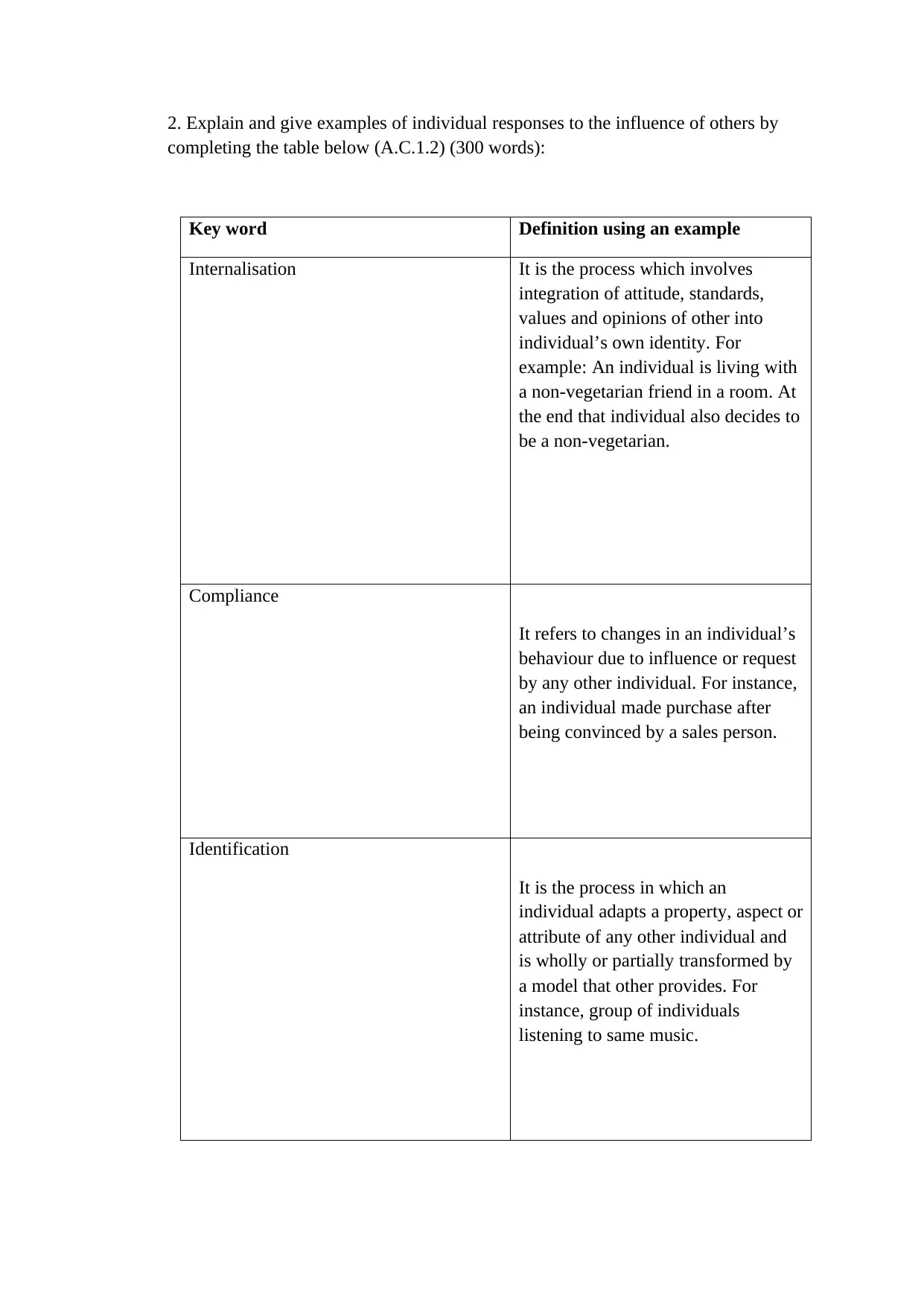
2. Explain and give examples of individual responses to the influence of others by
completing the table below (A.C.1.2) (300 words):
Key word Definition using an example
Internalisation It is the process which involves
integration of attitude, standards,
values and opinions of other into
individual’s own identity. For
example: An individual is living with
a non-vegetarian friend in a room. At
the end that individual also decides to
be a non-vegetarian.
Compliance
It refers to changes in an individual’s
behaviour due to influence or request
by any other individual. For instance,
an individual made purchase after
being convinced by a sales person.
Identification
It is the process in which an
individual adapts a property, aspect or
attribute of any other individual and
is wholly or partially transformed by
a model that other provides. For
instance, group of individuals
listening to same music.
completing the table below (A.C.1.2) (300 words):
Key word Definition using an example
Internalisation It is the process which involves
integration of attitude, standards,
values and opinions of other into
individual’s own identity. For
example: An individual is living with
a non-vegetarian friend in a room. At
the end that individual also decides to
be a non-vegetarian.
Compliance
It refers to changes in an individual’s
behaviour due to influence or request
by any other individual. For instance,
an individual made purchase after
being convinced by a sales person.
Identification
It is the process in which an
individual adapts a property, aspect or
attribute of any other individual and
is wholly or partially transformed by
a model that other provides. For
instance, group of individuals
listening to same music.
Paraphrase This Document
Need a fresh take? Get an instant paraphrase of this document with our AI Paraphraser
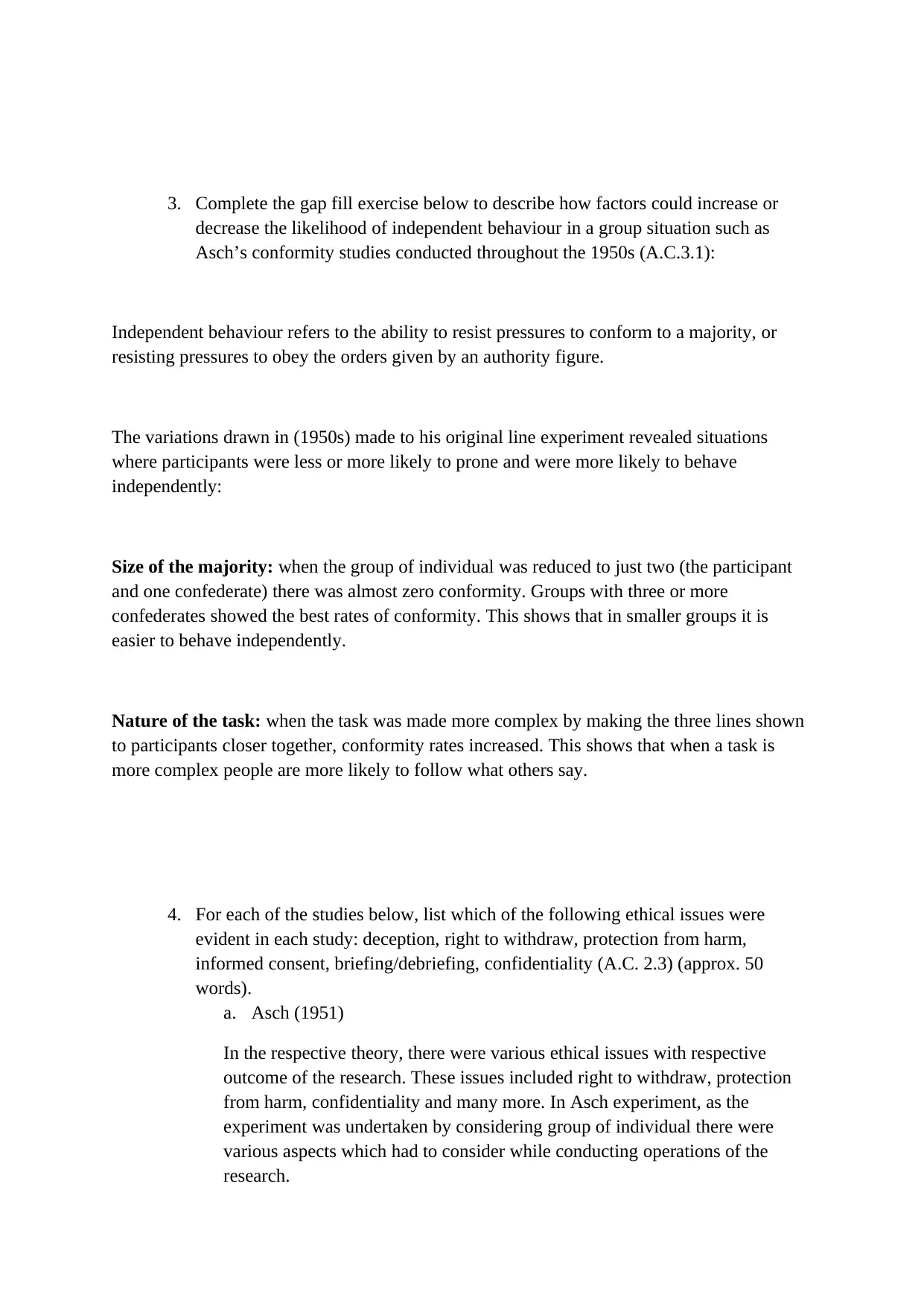
3. Complete the gap fill exercise below to describe how factors could increase or
decrease the likelihood of independent behaviour in a group situation such as
Asch’s conformity studies conducted throughout the 1950s (A.C.3.1):
Independent behaviour refers to the ability to resist pressures to conform to a majority, or
resisting pressures to obey the orders given by an authority figure.
The variations drawn in (1950s) made to his original line experiment revealed situations
where participants were less or more likely to prone and were more likely to behave
independently:
Size of the majority: when the group of individual was reduced to just two (the participant
and one confederate) there was almost zero conformity. Groups with three or more
confederates showed the best rates of conformity. This shows that in smaller groups it is
easier to behave independently.
Nature of the task: when the task was made more complex by making the three lines shown
to participants closer together, conformity rates increased. This shows that when a task is
more complex people are more likely to follow what others say.
4. For each of the studies below, list which of the following ethical issues were
evident in each study: deception, right to withdraw, protection from harm,
informed consent, briefing/debriefing, confidentiality (A.C. 2.3) (approx. 50
words).
a. Asch (1951)
In the respective theory, there were various ethical issues with respective
outcome of the research. These issues included right to withdraw, protection
from harm, confidentiality and many more. In Asch experiment, as the
experiment was undertaken by considering group of individual there were
various aspects which had to consider while conducting operations of the
research.
decrease the likelihood of independent behaviour in a group situation such as
Asch’s conformity studies conducted throughout the 1950s (A.C.3.1):
Independent behaviour refers to the ability to resist pressures to conform to a majority, or
resisting pressures to obey the orders given by an authority figure.
The variations drawn in (1950s) made to his original line experiment revealed situations
where participants were less or more likely to prone and were more likely to behave
independently:
Size of the majority: when the group of individual was reduced to just two (the participant
and one confederate) there was almost zero conformity. Groups with three or more
confederates showed the best rates of conformity. This shows that in smaller groups it is
easier to behave independently.
Nature of the task: when the task was made more complex by making the three lines shown
to participants closer together, conformity rates increased. This shows that when a task is
more complex people are more likely to follow what others say.
4. For each of the studies below, list which of the following ethical issues were
evident in each study: deception, right to withdraw, protection from harm,
informed consent, briefing/debriefing, confidentiality (A.C. 2.3) (approx. 50
words).
a. Asch (1951)
In the respective theory, there were various ethical issues with respective
outcome of the research. These issues included right to withdraw, protection
from harm, confidentiality and many more. In Asch experiment, as the
experiment was undertaken by considering group of individual there were
various aspects which had to consider while conducting operations of the
research.
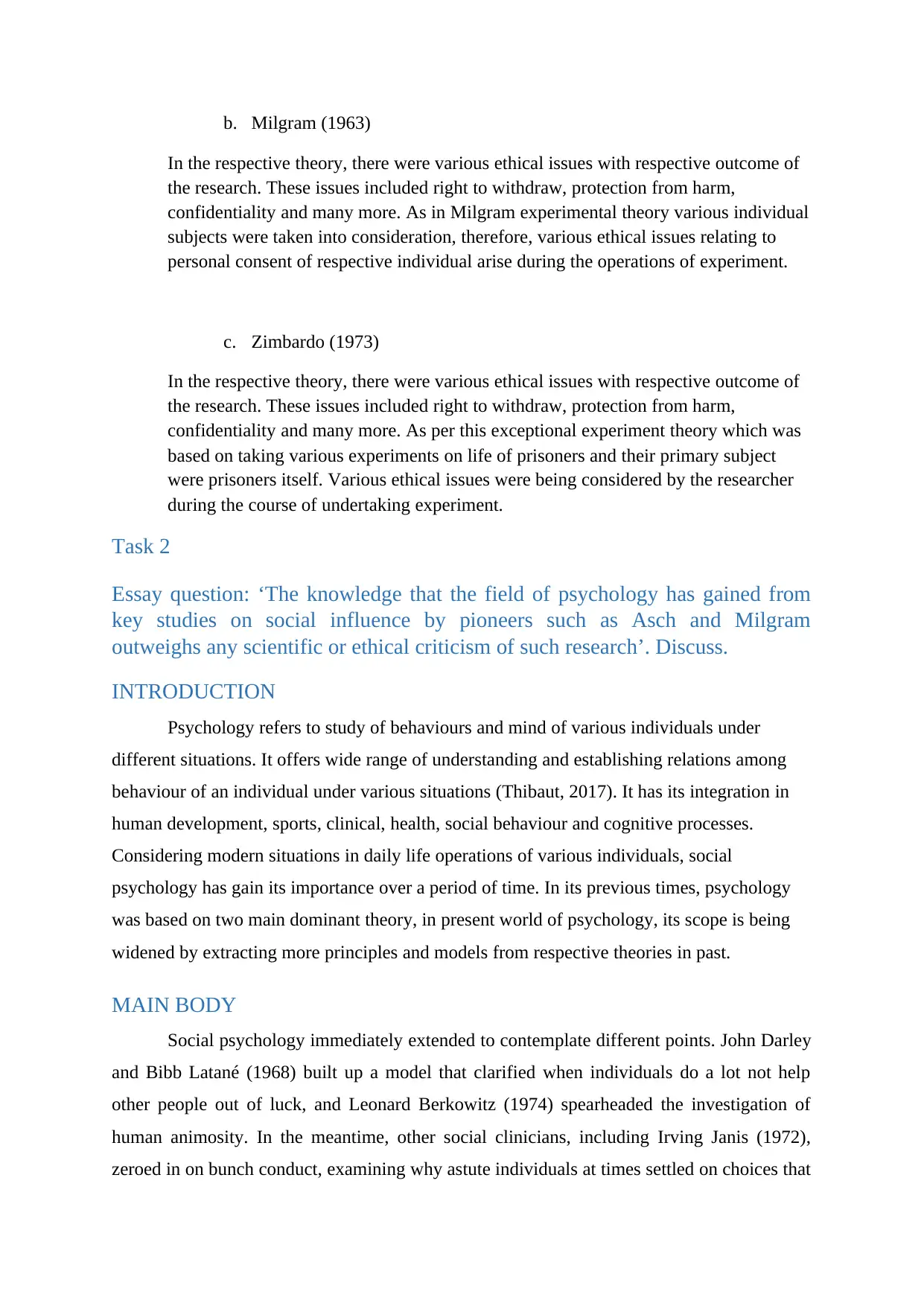
b. Milgram (1963)
In the respective theory, there were various ethical issues with respective outcome of
the research. These issues included right to withdraw, protection from harm,
confidentiality and many more. As in Milgram experimental theory various individual
subjects were taken into consideration, therefore, various ethical issues relating to
personal consent of respective individual arise during the operations of experiment.
c. Zimbardo (1973)
In the respective theory, there were various ethical issues with respective outcome of
the research. These issues included right to withdraw, protection from harm,
confidentiality and many more. As per this exceptional experiment theory which was
based on taking various experiments on life of prisoners and their primary subject
were prisoners itself. Various ethical issues were being considered by the researcher
during the course of undertaking experiment.
Task 2
Essay question: ‘The knowledge that the field of psychology has gained from
key studies on social influence by pioneers such as Asch and Milgram
outweighs any scientific or ethical criticism of such research’. Discuss.
INTRODUCTION
Psychology refers to study of behaviours and mind of various individuals under
different situations. It offers wide range of understanding and establishing relations among
behaviour of an individual under various situations (Thibaut, 2017). It has its integration in
human development, sports, clinical, health, social behaviour and cognitive processes.
Considering modern situations in daily life operations of various individuals, social
psychology has gain its importance over a period of time. In its previous times, psychology
was based on two main dominant theory, in present world of psychology, its scope is being
widened by extracting more principles and models from respective theories in past.
MAIN BODY
Social psychology immediately extended to contemplate different points. John Darley
and Bibb Latané (1968) built up a model that clarified when individuals do a lot not help
other people out of luck, and Leonard Berkowitz (1974) spearheaded the investigation of
human animosity. In the meantime, other social clinicians, including Irving Janis (1972),
zeroed in on bunch conduct, examining why astute individuals at times settled on choices that
In the respective theory, there were various ethical issues with respective outcome of
the research. These issues included right to withdraw, protection from harm,
confidentiality and many more. As in Milgram experimental theory various individual
subjects were taken into consideration, therefore, various ethical issues relating to
personal consent of respective individual arise during the operations of experiment.
c. Zimbardo (1973)
In the respective theory, there were various ethical issues with respective outcome of
the research. These issues included right to withdraw, protection from harm,
confidentiality and many more. As per this exceptional experiment theory which was
based on taking various experiments on life of prisoners and their primary subject
were prisoners itself. Various ethical issues were being considered by the researcher
during the course of undertaking experiment.
Task 2
Essay question: ‘The knowledge that the field of psychology has gained from
key studies on social influence by pioneers such as Asch and Milgram
outweighs any scientific or ethical criticism of such research’. Discuss.
INTRODUCTION
Psychology refers to study of behaviours and mind of various individuals under
different situations. It offers wide range of understanding and establishing relations among
behaviour of an individual under various situations (Thibaut, 2017). It has its integration in
human development, sports, clinical, health, social behaviour and cognitive processes.
Considering modern situations in daily life operations of various individuals, social
psychology has gain its importance over a period of time. In its previous times, psychology
was based on two main dominant theory, in present world of psychology, its scope is being
widened by extracting more principles and models from respective theories in past.
MAIN BODY
Social psychology immediately extended to contemplate different points. John Darley
and Bibb Latané (1968) built up a model that clarified when individuals do a lot not help
other people out of luck, and Leonard Berkowitz (1974) spearheaded the investigation of
human animosity. In the meantime, other social clinicians, including Irving Janis (1972),
zeroed in on bunch conduct, examining why astute individuals at times settled on choices that
⊘ This is a preview!⊘
Do you want full access?
Subscribe today to unlock all pages.

Trusted by 1+ million students worldwide
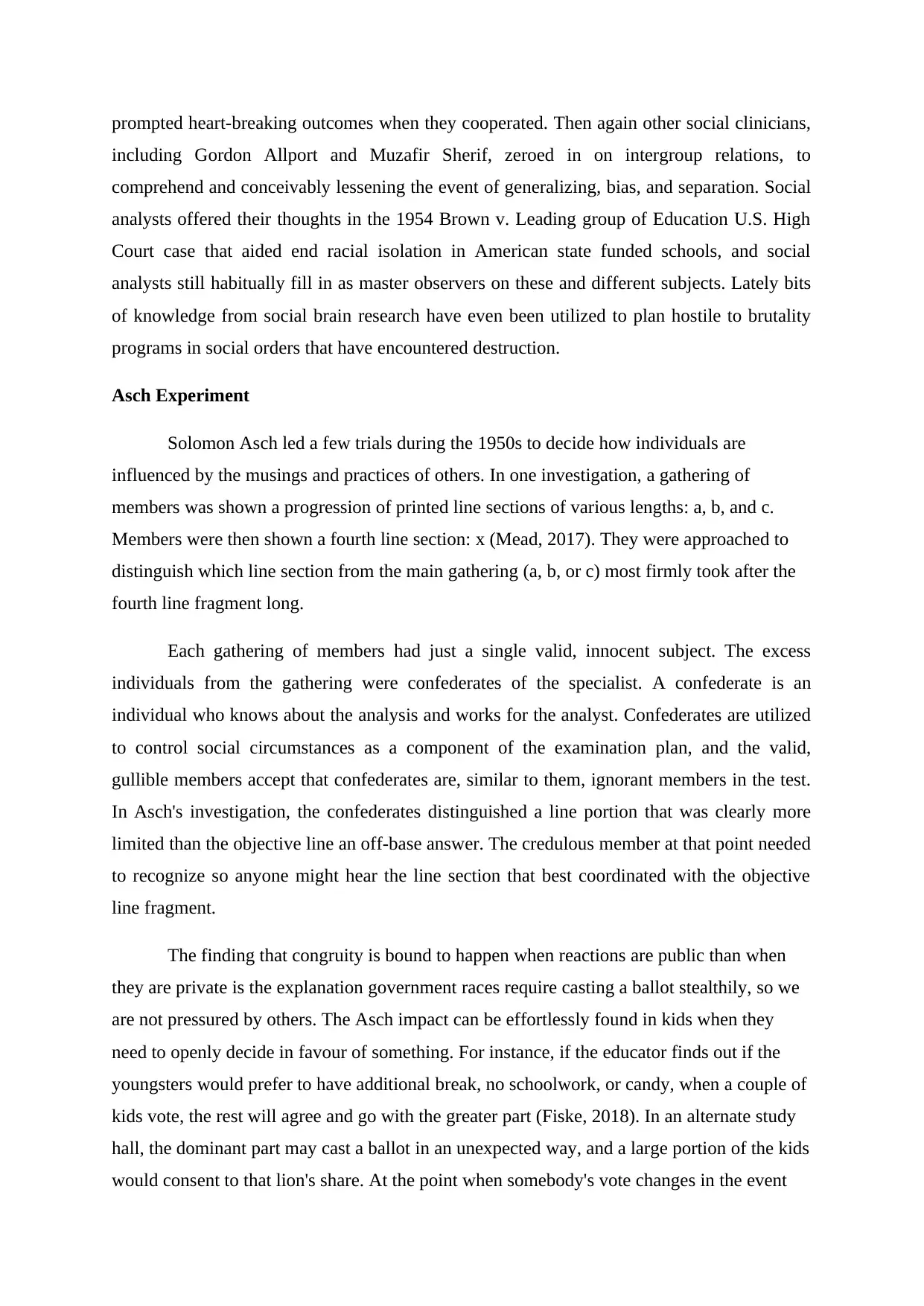
prompted heart-breaking outcomes when they cooperated. Then again other social clinicians,
including Gordon Allport and Muzafir Sherif, zeroed in on intergroup relations, to
comprehend and conceivably lessening the event of generalizing, bias, and separation. Social
analysts offered their thoughts in the 1954 Brown v. Leading group of Education U.S. High
Court case that aided end racial isolation in American state funded schools, and social
analysts still habitually fill in as master observers on these and different subjects. Lately bits
of knowledge from social brain research have even been utilized to plan hostile to brutality
programs in social orders that have encountered destruction.
Asch Experiment
Solomon Asch led a few trials during the 1950s to decide how individuals are
influenced by the musings and practices of others. In one investigation, a gathering of
members was shown a progression of printed line sections of various lengths: a, b, and c.
Members were then shown a fourth line section: x (Mead, 2017). They were approached to
distinguish which line section from the main gathering (a, b, or c) most firmly took after the
fourth line fragment long.
Each gathering of members had just a single valid, innocent subject. The excess
individuals from the gathering were confederates of the specialist. A confederate is an
individual who knows about the analysis and works for the analyst. Confederates are utilized
to control social circumstances as a component of the examination plan, and the valid,
gullible members accept that confederates are, similar to them, ignorant members in the test.
In Asch's investigation, the confederates distinguished a line portion that was clearly more
limited than the objective line an off-base answer. The credulous member at that point needed
to recognize so anyone might hear the line section that best coordinated with the objective
line fragment.
The finding that congruity is bound to happen when reactions are public than when
they are private is the explanation government races require casting a ballot stealthily, so we
are not pressured by others. The Asch impact can be effortlessly found in kids when they
need to openly decide in favour of something. For instance, if the educator finds out if the
youngsters would prefer to have additional break, no schoolwork, or candy, when a couple of
kids vote, the rest will agree and go with the greater part (Fiske, 2018). In an alternate study
hall, the dominant part may cast a ballot in an unexpected way, and a large portion of the kids
would consent to that lion's share. At the point when somebody's vote changes in the event
including Gordon Allport and Muzafir Sherif, zeroed in on intergroup relations, to
comprehend and conceivably lessening the event of generalizing, bias, and separation. Social
analysts offered their thoughts in the 1954 Brown v. Leading group of Education U.S. High
Court case that aided end racial isolation in American state funded schools, and social
analysts still habitually fill in as master observers on these and different subjects. Lately bits
of knowledge from social brain research have even been utilized to plan hostile to brutality
programs in social orders that have encountered destruction.
Asch Experiment
Solomon Asch led a few trials during the 1950s to decide how individuals are
influenced by the musings and practices of others. In one investigation, a gathering of
members was shown a progression of printed line sections of various lengths: a, b, and c.
Members were then shown a fourth line section: x (Mead, 2017). They were approached to
distinguish which line section from the main gathering (a, b, or c) most firmly took after the
fourth line fragment long.
Each gathering of members had just a single valid, innocent subject. The excess
individuals from the gathering were confederates of the specialist. A confederate is an
individual who knows about the analysis and works for the analyst. Confederates are utilized
to control social circumstances as a component of the examination plan, and the valid,
gullible members accept that confederates are, similar to them, ignorant members in the test.
In Asch's investigation, the confederates distinguished a line portion that was clearly more
limited than the objective line an off-base answer. The credulous member at that point needed
to recognize so anyone might hear the line section that best coordinated with the objective
line fragment.
The finding that congruity is bound to happen when reactions are public than when
they are private is the explanation government races require casting a ballot stealthily, so we
are not pressured by others. The Asch impact can be effortlessly found in kids when they
need to openly decide in favour of something. For instance, if the educator finds out if the
youngsters would prefer to have additional break, no schoolwork, or candy, when a couple of
kids vote, the rest will agree and go with the greater part (Fiske, 2018). In an alternate study
hall, the dominant part may cast a ballot in an unexpected way, and a large portion of the kids
would consent to that lion's share. At the point when somebody's vote changes in the event
Paraphrase This Document
Need a fresh take? Get an instant paraphrase of this document with our AI Paraphraser
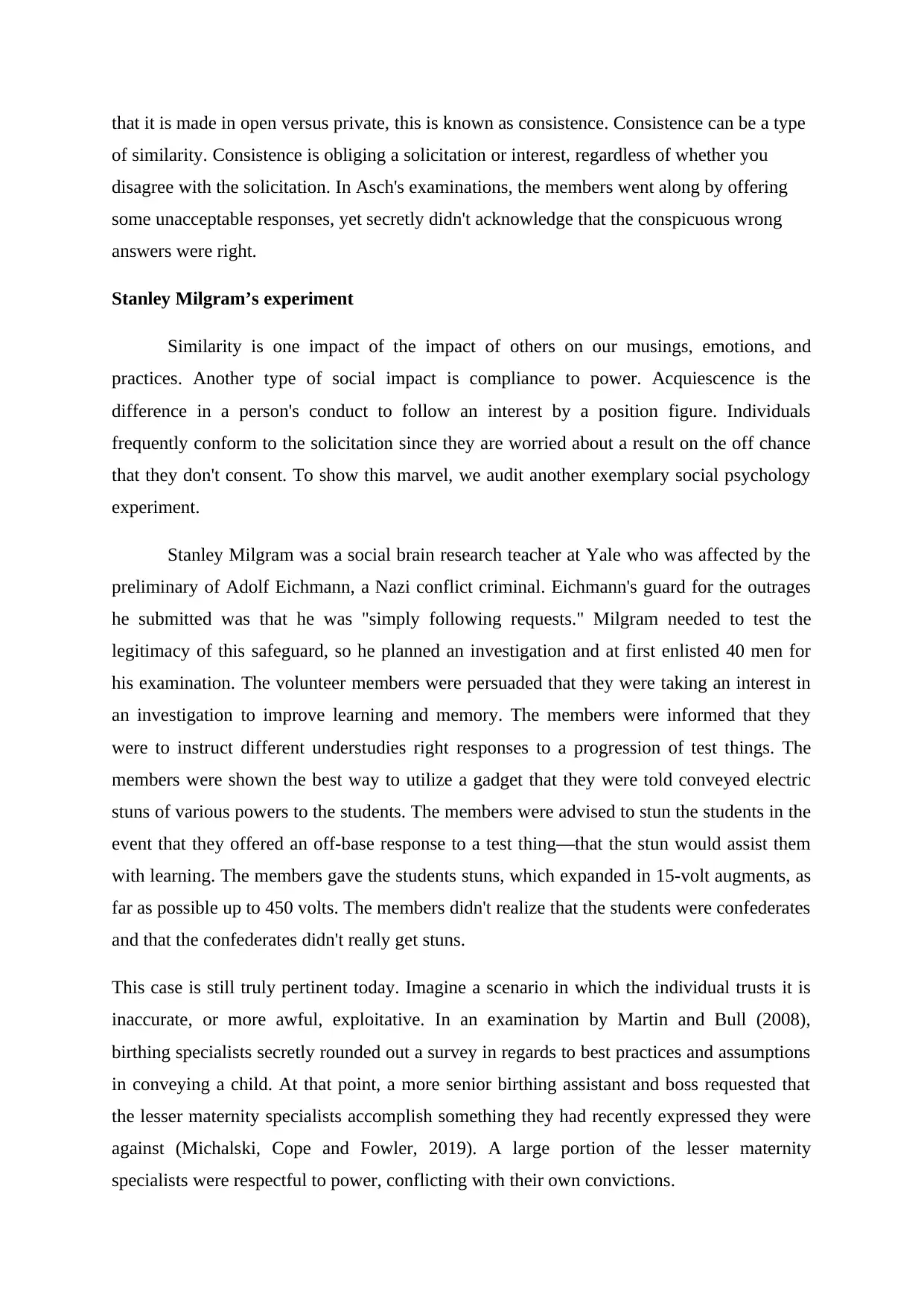
that it is made in open versus private, this is known as consistence. Consistence can be a type
of similarity. Consistence is obliging a solicitation or interest, regardless of whether you
disagree with the solicitation. In Asch's examinations, the members went along by offering
some unacceptable responses, yet secretly didn't acknowledge that the conspicuous wrong
answers were right.
Stanley Milgram’s experiment
Similarity is one impact of the impact of others on our musings, emotions, and
practices. Another type of social impact is compliance to power. Acquiescence is the
difference in a person's conduct to follow an interest by a position figure. Individuals
frequently conform to the solicitation since they are worried about a result on the off chance
that they don't consent. To show this marvel, we audit another exemplary social psychology
experiment.
Stanley Milgram was a social brain research teacher at Yale who was affected by the
preliminary of Adolf Eichmann, a Nazi conflict criminal. Eichmann's guard for the outrages
he submitted was that he was "simply following requests." Milgram needed to test the
legitimacy of this safeguard, so he planned an investigation and at first enlisted 40 men for
his examination. The volunteer members were persuaded that they were taking an interest in
an investigation to improve learning and memory. The members were informed that they
were to instruct different understudies right responses to a progression of test things. The
members were shown the best way to utilize a gadget that they were told conveyed electric
stuns of various powers to the students. The members were advised to stun the students in the
event that they offered an off-base response to a test thing—that the stun would assist them
with learning. The members gave the students stuns, which expanded in 15-volt augments, as
far as possible up to 450 volts. The members didn't realize that the students were confederates
and that the confederates didn't really get stuns.
This case is still truly pertinent today. Imagine a scenario in which the individual trusts it is
inaccurate, or more awful, exploitative. In an examination by Martin and Bull (2008),
birthing specialists secretly rounded out a survey in regards to best practices and assumptions
in conveying a child. At that point, a more senior birthing assistant and boss requested that
the lesser maternity specialists accomplish something they had recently expressed they were
against (Michalski, Cope and Fowler, 2019). A large portion of the lesser maternity
specialists were respectful to power, conflicting with their own convictions.
of similarity. Consistence is obliging a solicitation or interest, regardless of whether you
disagree with the solicitation. In Asch's examinations, the members went along by offering
some unacceptable responses, yet secretly didn't acknowledge that the conspicuous wrong
answers were right.
Stanley Milgram’s experiment
Similarity is one impact of the impact of others on our musings, emotions, and
practices. Another type of social impact is compliance to power. Acquiescence is the
difference in a person's conduct to follow an interest by a position figure. Individuals
frequently conform to the solicitation since they are worried about a result on the off chance
that they don't consent. To show this marvel, we audit another exemplary social psychology
experiment.
Stanley Milgram was a social brain research teacher at Yale who was affected by the
preliminary of Adolf Eichmann, a Nazi conflict criminal. Eichmann's guard for the outrages
he submitted was that he was "simply following requests." Milgram needed to test the
legitimacy of this safeguard, so he planned an investigation and at first enlisted 40 men for
his examination. The volunteer members were persuaded that they were taking an interest in
an investigation to improve learning and memory. The members were informed that they
were to instruct different understudies right responses to a progression of test things. The
members were shown the best way to utilize a gadget that they were told conveyed electric
stuns of various powers to the students. The members were advised to stun the students in the
event that they offered an off-base response to a test thing—that the stun would assist them
with learning. The members gave the students stuns, which expanded in 15-volt augments, as
far as possible up to 450 volts. The members didn't realize that the students were confederates
and that the confederates didn't really get stuns.
This case is still truly pertinent today. Imagine a scenario in which the individual trusts it is
inaccurate, or more awful, exploitative. In an examination by Martin and Bull (2008),
birthing specialists secretly rounded out a survey in regards to best practices and assumptions
in conveying a child. At that point, a more senior birthing assistant and boss requested that
the lesser maternity specialists accomplish something they had recently expressed they were
against (Michalski, Cope and Fowler, 2019). A large portion of the lesser maternity
specialists were respectful to power, conflicting with their own convictions.
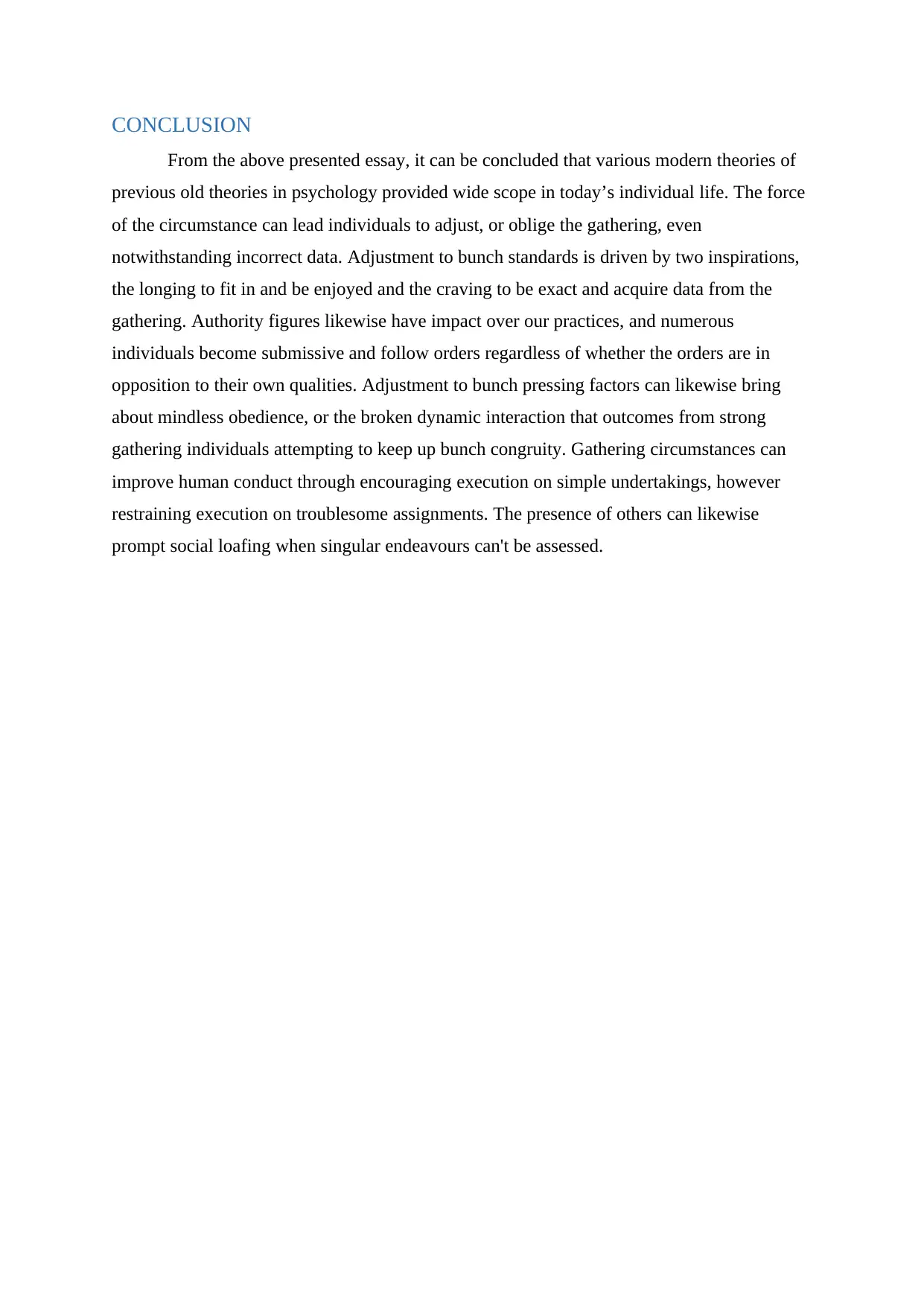
CONCLUSION
From the above presented essay, it can be concluded that various modern theories of
previous old theories in psychology provided wide scope in today’s individual life. The force
of the circumstance can lead individuals to adjust, or oblige the gathering, even
notwithstanding incorrect data. Adjustment to bunch standards is driven by two inspirations,
the longing to fit in and be enjoyed and the craving to be exact and acquire data from the
gathering. Authority figures likewise have impact over our practices, and numerous
individuals become submissive and follow orders regardless of whether the orders are in
opposition to their own qualities. Adjustment to bunch pressing factors can likewise bring
about mindless obedience, or the broken dynamic interaction that outcomes from strong
gathering individuals attempting to keep up bunch congruity. Gathering circumstances can
improve human conduct through encouraging execution on simple undertakings, however
restraining execution on troublesome assignments. The presence of others can likewise
prompt social loafing when singular endeavours can't be assessed.
From the above presented essay, it can be concluded that various modern theories of
previous old theories in psychology provided wide scope in today’s individual life. The force
of the circumstance can lead individuals to adjust, or oblige the gathering, even
notwithstanding incorrect data. Adjustment to bunch standards is driven by two inspirations,
the longing to fit in and be enjoyed and the craving to be exact and acquire data from the
gathering. Authority figures likewise have impact over our practices, and numerous
individuals become submissive and follow orders regardless of whether the orders are in
opposition to their own qualities. Adjustment to bunch pressing factors can likewise bring
about mindless obedience, or the broken dynamic interaction that outcomes from strong
gathering individuals attempting to keep up bunch congruity. Gathering circumstances can
improve human conduct through encouraging execution on simple undertakings, however
restraining execution on troublesome assignments. The presence of others can likewise
prompt social loafing when singular endeavours can't be assessed.
⊘ This is a preview!⊘
Do you want full access?
Subscribe today to unlock all pages.

Trusted by 1+ million students worldwide
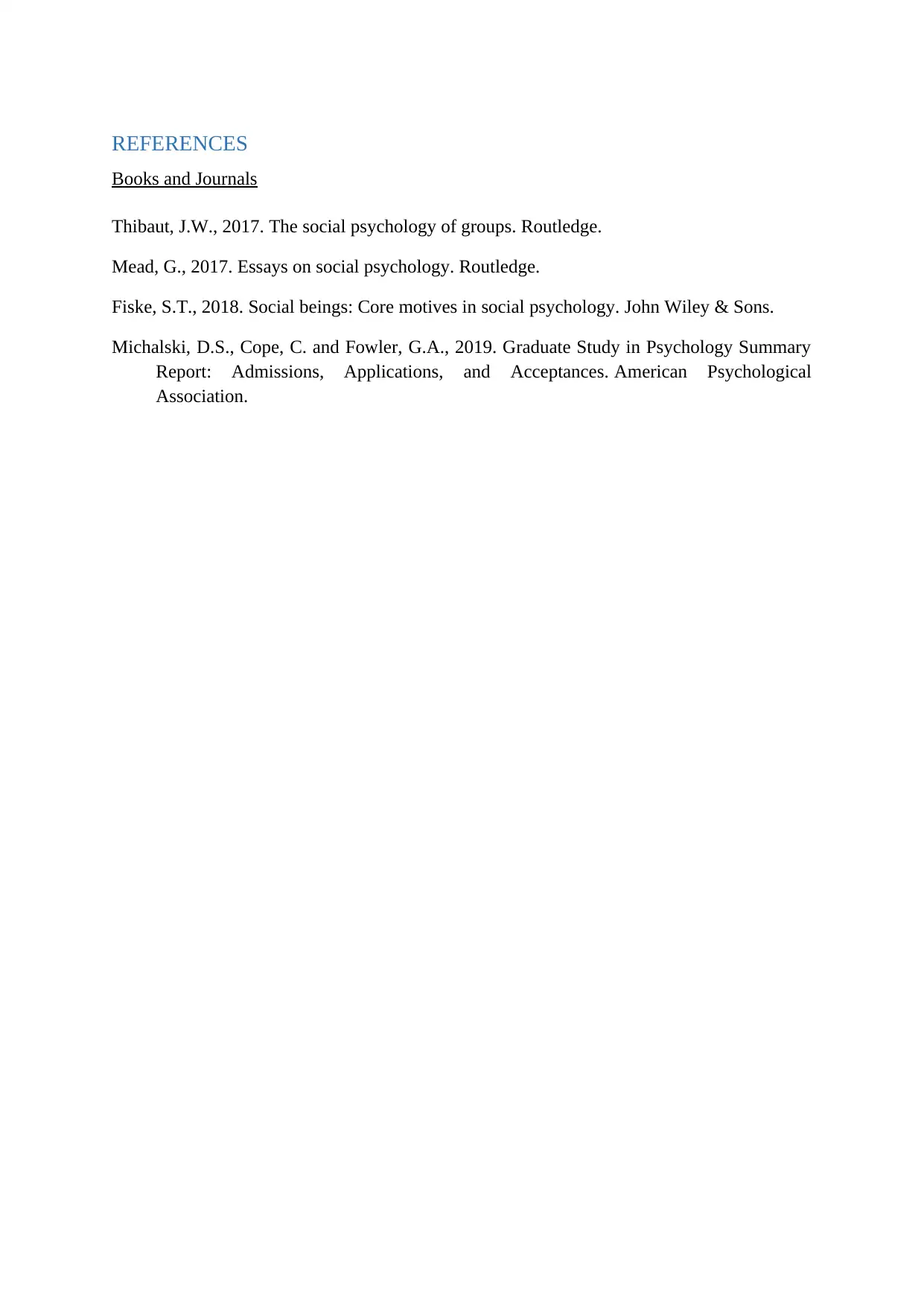
REFERENCES
Books and Journals
Thibaut, J.W., 2017. The social psychology of groups. Routledge.
Mead, G., 2017. Essays on social psychology. Routledge.
Fiske, S.T., 2018. Social beings: Core motives in social psychology. John Wiley & Sons.
Michalski, D.S., Cope, C. and Fowler, G.A., 2019. Graduate Study in Psychology Summary
Report: Admissions, Applications, and Acceptances. American Psychological
Association.
Books and Journals
Thibaut, J.W., 2017. The social psychology of groups. Routledge.
Mead, G., 2017. Essays on social psychology. Routledge.
Fiske, S.T., 2018. Social beings: Core motives in social psychology. John Wiley & Sons.
Michalski, D.S., Cope, C. and Fowler, G.A., 2019. Graduate Study in Psychology Summary
Report: Admissions, Applications, and Acceptances. American Psychological
Association.
1 out of 10
Related Documents
Your All-in-One AI-Powered Toolkit for Academic Success.
+13062052269
info@desklib.com
Available 24*7 on WhatsApp / Email
![[object Object]](/_next/static/media/star-bottom.7253800d.svg)
Unlock your academic potential
Copyright © 2020–2025 A2Z Services. All Rights Reserved. Developed and managed by ZUCOL.





